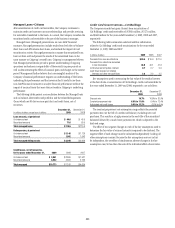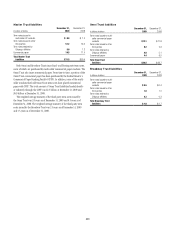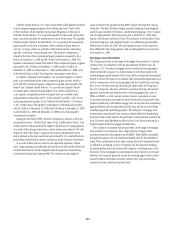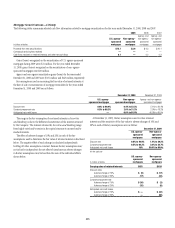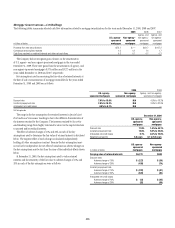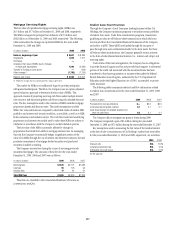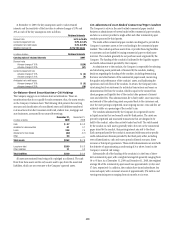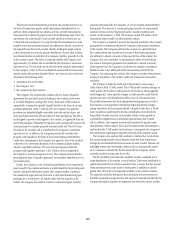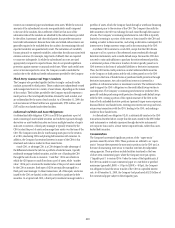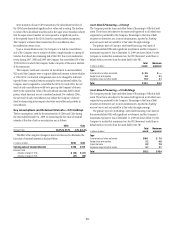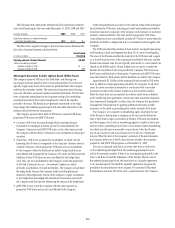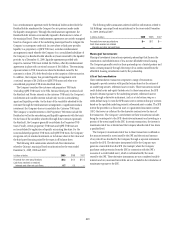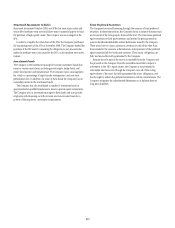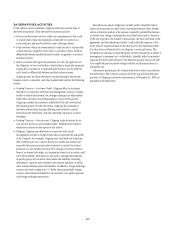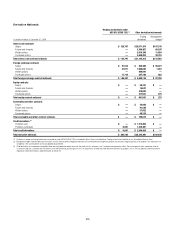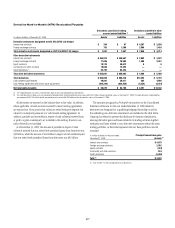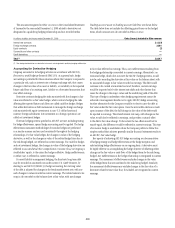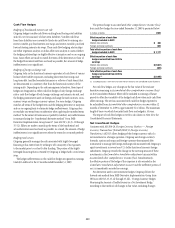Citibank 2009 Annual Report Download - page 220
Download and view the complete annual report
Please find page 220 of the 2009 Citibank annual report below. You can navigate through the pages in the report by either clicking on the pages listed below, or by using the keyword search tool below to find specific information within the annual report.210
investors in commercial paper and medium-term notes. While the notional
amounts of the subordinate loss notes are quantitatively small compared
to the size of the conduits, this is reflective of the fact that most of the
substantive risks of the conduits are absorbed by the enhancements provided
by the sellers (customers) and other third parties that provide transaction-
level credit enhancement. Because these risks and related enhancements are
generally required to be excluded from the analysis, the remaining risks and
expected variability are quantitatively small. The calculation of variability
focuses primarily on expected variability, rather than the risks associated with
extreme outcomes (for example, large levels of default) that are expected
to occur very infrequently. So while the subordinate loss notes are sized
appropriately compared to expected losses, they do not provide significant
protection against extreme or unusual credit losses. Where such credit losses
occur or become expected to occur, the Company would consolidate the
conduit due to the additional credit enhancement provided by the Company.
Third-Party Commercial Paper Conduits
The Company also provides liquidity facilities to single- and multi-seller
conduits sponsored by third parties. These conduits are independently owned
and managed and invest in a variety of asset classes, depending on the nature
of the conduit. The facilities provided by the Company typically represent a
small portion of the total liquidity facilities obtained by each conduit, and
are collateralized by the assets of each conduit. As of December 31, 2009, the
notional amount of these facilities was approximately $792 million, and
$187 million was funded under these facilities.
Collateralized Debt and Loan Obligations
A collateralized debt obligation (CDO) is an SPE that purchases a pool of
assets consisting of asset-backed securities and synthetic exposures through
derivatives on asset-backed securities and issues multiple tranches of equity
and notes to investors. A third-party manager is typically retained by the
CDO to select the pool of assets and manage those assets over the term of the
CDO. The Company earns fees for warehousing assets prior to the creation
of a CDO, structuring CDOs and placing debt securities with investors. In
addition, the Company has retained interests in many of the CDOs it has
structured and makes a market in those issued notes.
A cash CDO, or arbitrage CDO, is a CDO designed to take advantage of
the difference between the yield on a portfolio of selected assets, typically
residential mortgage-backed securities, and the cost of funding the CDO
through the sale of notes to investors. “Cash flow” CDOs are vehicles in
which the CDO passes on cash flows from a pool of assets, while “market
value” CDOs pay to investors the market value of the pool of assets owned
by the CDO at maturity. Both types of CDOs are typically managed by a
third-party asset manager. In these transactions, all of the equity and notes
issued by the CDO are funded, as the cash is needed to purchase the debt
securities. In a typical cash CDO, a third-party investment manager selects a
portfolio of assets, which the Company funds through a warehouse financing
arrangement prior to the creation of the CDO. The Company then sells the
debt securities to the CDO in exchange for cash raised through the issuance
of notes. The Company’s continuing involvement in cash CDOs is typically
limited to investing in a portion of the notes or loans issued by the CDO and
making a market in those securities, and acting as derivative counterparty for
interest rate or foreign currency swaps used in the structuring of the CDO.
A synthetic CDO is similar to a cash CDO, except that the CDO obtains
exposure to all or a portion of the referenced assets synthetically through
derivative instruments, such as credit default swaps. Because the CDO does
not need to raise cash sufficient to purchase the entire referenced portfolio,
a substantial portion of the senior tranches of risk is typically passed on to
CDO investors in the form of unfunded liabilities or derivative instruments.
Thus, the CDO writes credit protection on select referenced debt securities
to the Company or third parties and the risk is then passed on to the CDO
investors in the form of funded notes or purchased credit protection through
derivative instruments. Any cash raised from investors is invested in a
portfolio of collateral securities or investment contracts. The collateral is then
used to support the CDO’s obligations on the credit default swaps written to
counterparties. The Company’s continuing involvement in synthetic CDOs
generally includes purchasing credit protection through credit default swaps
with the CDO, owning a portion of the capital structure of the CDO in the
form of both unfunded derivative positions (primarily super-senior exposures
discussed below) and funded notes, entering into interest-rate swap and total-
return swap transactions with the CDO, lending to the CDO, and making a
market in those funded notes.
A collateralized loan obligation (CLO) is substantially similar to the CDO
transactions described above, except that the assets owned by the SPE (either
cash instruments or synthetic exposures through derivative instruments)
are corporate loans and to a lesser extent corporate bonds, rather than asset-
backed debt securities.
Consolidation
The Company has retained significant portions of the “super-senior”
positions issued by certain CDOs. These positions are referred to as “super-
senior” because they represent the most senior positions in the CDO and, at
the time of structuring, were senior to tranches rated AAA by independent
rating agencies. These positions include facilities structured in the form
of short-term commercial paper, where the Company wrote put options
(“liquidity puts”) to certain CDOs. Under the terms of the liquidity puts, if
the CDO was unable to issue commercial paper at a rate below a specified
maximum (generally LIBOR + 35 bps to LIBOR + 40 bps), the Company
was obligated to fund the senior tranche of the CDO at a specified interest
rate. As of December 31, 2009, the Company had purchased all $25 billion of
the commercial paper subject to these liquidity puts.



